Day 151 (8th of August, 2016) – Petra, Jordan
(continued from 7th of August)
In the evening, I met my travel companions for the next week and a half. The group is sixteen strong until Israel, at which point it drops to just five people. In the group, ten are Australian. The others are from America, Germany, England and New Zealand. My roommate, Terry, is from Nowra (a few hours away from Sydney). He’s 30 years old, and lives in London working as a nurse. He decided almost on a whim to pack up and leave, and has no plans on returning to Australia. His lifestyle in London sounds very attractive – it cemented my idea that it would be a city which I would love to live in at some point in the future (even if only for a short time). Three other people in the group were living in London and reaffirmed that for me.
After a quick group briefing session, most of us headed out to a famous eatery called ‘Hashem’, which is known for its hummus. I happily followed along. It was a fair way from the hotel, but the people on the tour chose it because they wanted to get out of the ‘dry zone’ which our hotel was located in (no alcohol is sold because of its proximity to a mosque).
The food consisted of a huge range of hummus and baba ghanoush which you dipped bread in. The price was cheap for the amount that we were served, and the atmosphere was very casual. You didn’t order – they simply handed you the food. At the end, we all watched a waiter who hadn’t even served us stealthily pocket our tip before depositing the rest of the bill in the teller.
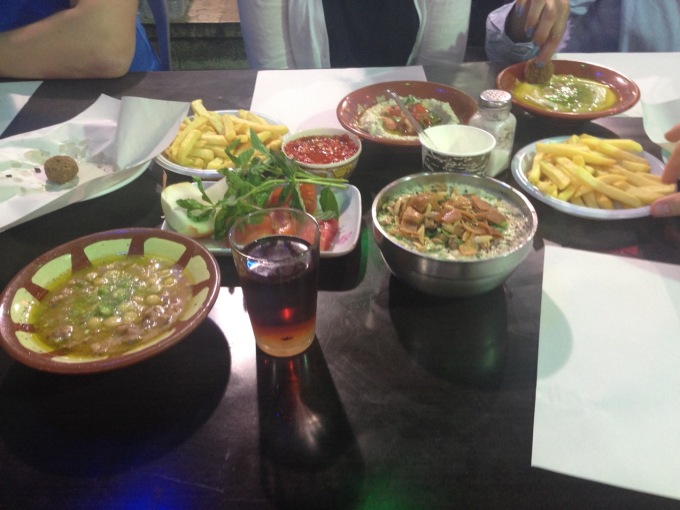
The city centre itself was pretty. Driving here is still dangerous, but nowhere near as bad as China, Thailand or Iran. Unfortunately we didn’t find any bars, so we headed back to the hotel prematurely to get a good rest.
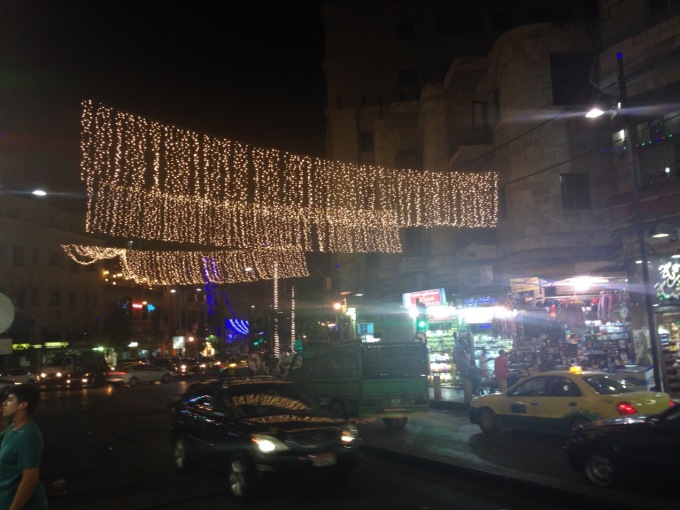
The next morning, we all struggled to fit our luggage in the hopelessly small minibus for the four hour drive from Amman to Petra. Luckily, the drive was broken up by many interesting stops.
The first stop was Madaba – a city known for its Byzantine and Umayyad mosaics. It features in the Bible in both Numbers and Joshua. The most famous site in the town is the Greek Orthodox Basilica of Saint George.

Here, we learned a lot about the changing borders of different lands in the region over history. The most significant feature of the church was the mosaic map of the Holy Lands on the floor. This centrepiece was extraordinarily detailed, and it put into perspective just how close we were to so many locations mentioned in the Bible.

Madaba is situated at the top of the map. Below it you can see the Dead Sea which we will visit in a few days. The small canal coming out of it on the left is the River Jordan, where John the Baptist is believed to have baptised Jesus. The main circular structure in the centre of the photo is Jerusalem which is across the border in Israel.
The church was adorned with many mosaics – surely the first of many for the trip.

The town surrounding the church was also picturesque. The fresh air on the top of the mountain gave it a really refreshing feeling.

The next stop was Mount Nebo. Mount Nebo is where Moses was granted a view of the Promised Land. According to the final chapter of the Book of Deuteronomy, Moses ascended Mount Nebo to view the Land of Israel (which God had said he would not enter) before dying on the mountain. He was buried in an unknown valley location in Moab.

The Cathedral and museums on top of the mountain were filled with ancient artefacts dating back to the time of Moses and even before.
What amazes me about being in this part of the world is the sheer amount of Holy landmarks you can see. It is quite unbelievable driving along a highway and having your guide say “this is where Jesus did this”, “this is where Jesus did that”.
This is the view that Moses showed to his people.

Unfortunately it wasn’t as clear as it normally is, but you can faintly make out the Dead Sea in this direction.

On a clearer day, you can even see Jerusalem on the Mount of Olives, Bethlehem and Jericho.
While driving along the famous King’s Way highway, we also stopped at a mosaic shop to see how the artists make the artworks.

The King’s Highway was a trade route of vital importance to the ancient Near East. It began in Egypt and stretched across the Sinai Peninsula to Aqaba in Jordan. From there it turned northward across Transjordan, leading to Damascus in Syria and the Euphrates River. Since the Muslim conquest in the 7th century AD and until the 16th century it served as the ‘darb al-hajj’ or pilgrimage road for Muslims coming from Syria, Iraq and beyond and heading for the holy city of Mecca in Saudi Arabia.
To be honest, I didn’t wholly enjoy the mosaic shop. The company I’m doing this with, Topdeck, uses their own Australian or Kiwi guides for most of their trips. In the Middle East, though, they contract out their work to other companies. This creates room for taking you to places which give out a commission to the tour guide, which is of course against Topdeck policy.
There was no hiding the fact that this mosaic gallery was in the business of giving commissions to tours. The information on the mosaics was more about their free shipping than how they were actually made. Our guide seemed not to bother hiding the fact that he knew the owners very well too.
The works were still stunning, though.

Along King’s Way there were many remarkable views. The guide suggested that we pull over at a viewpoint to take in the scenery.
Around an hour further along the highway was Karak Castle. This structure was a fort for the Christian Crusaders from the 1140s. The Crusaders ruled over the town below known as ‘Al-Karak’. Al-Karak was inhabited from the Iron Age and was an important city for the Moabites. It is featured in the Bible as the place where the Syrians went before they settled in the regions in the northern of Levant in the Book of Kings and Book of Amos.

The castle itself was very large, and it required a few hours of exploration. It makes me excited for being able to see more castles in the future in Europe.
As you wound your way through the tunnels and dungeons, you would occasionally exit a door only to find yourself teetering off the edge of a cliff.

Many of the embrasures were still intact.

You had to be careful that you wouldn’t accidentally step on any of the discrete holes in the floor, too.

My favourite bit was getting lost in some of the deeper, darker tunnels. It’s amazing thinking of how these were actually used during the Middle Ages.
We drove into the town of Petra as the sun set.

Here, we had the opportunity to pay some more money to see Petra by night. Petra was a city carved out of rock which prospered as the capital of the Nabataean Empire from the 1st century BC. It grew rich through trade in frankincense, myrrh and spices. It was later annexed to the Roman Empire and continued to thrive until a large earthquake in 363 AD destroyed much of the city. Sanctions by the Roman Empire through changing trade routes led to the downfall and abandonment of the city. Only the local Bedouin people remained in the area, and the city remained undiscovered until 1812.
We were told that we would get to spend the whole day tomorrow perusing Petra, and that tonight was more if we wanted to take in the incredible view of thousands of candles illuminating the site. I jumped at the opportunity.
Unfortunately my camera was very low on battery which combined with the poor lighting to create some pretty dodgy photos.
All I can say, though, is that this was one of the most spectacular views I have ever been witness to. I found myself genuinely in awe as I wandered down the Siq – a natural stone corridor which spans 2km and leads you into the city.
The midnight blues of the sky were the perfect backdrop to the orange glow of the rock.
Upon reaching the end of the Siq, my breath was taken away by the site of the Treasury.

Here, we sat drinking tea and listening to the dramatic performance of a local Jordanian explaining the history of the place. Since my camera wasn’t handling the scene very well, I’ve found a photo which does justice to the scene I saw this evening.

It stood out as one of my highlights of the year, and I made sure to slow my walk on the way back to take everything in.
Day 152 (9th of August, 2016) – Petra, Jordan
When the first light cracked into my room in the early morning, I quickly ran to my phone. I’ve been awaiting an email regarding the outcome of my scholarship for a couple of days.
The email started off in a worrying way.
“The twenty who were shortlisted brought very different profiles to the table, and we found it a difficult task to differentiate you all into an order.”
Oh no, I thought. I was mentally preparing myself to read that one killer word – “unfortunately”.
But it never came.
“I’m delighted to tell you that we have chosen you as one of the 2017 St Andrew’s Scholars.”
My heart raced. I’m still struggling to believe it as I type this. I’m overjoyed with the privilege of having received a scholarship for a College residence at University. I can’t underestimate the advantage it will be not having any student debt to worry about!
Most of all, though, the scholarship comes with an obligation to perform. I greatly look forward to coming out of the gates strongly in February next year.
I decided to celebrate by giving myself an extra hour of sleep. Setting my alarm in a daze, I made the critical mistake of selecting PM instead of AM. Half an hour after we were supposed to leave on the tour bus, I was woken by a call on the hotel phone telling me that I was being waited on by the group.
I hastily packed and did the walk of shame onto the bus without breakfast.
The embarrassment was short-lived. Soon, the magnificence of Petra was at the forefront of my mind.
Embarking on the same walk as last night was a completely different experience in the daytime.
The road was lined with tombs, storage rooms and small water canals all carved out of the rock. Entering the Siq was even more unbelievable.
You could spot the occasional carving on the walls of the Siq. Here, you can barely see the legs of a man and his camels.

The colours of the rock really struck me. Their marbling was a magnificent sight.
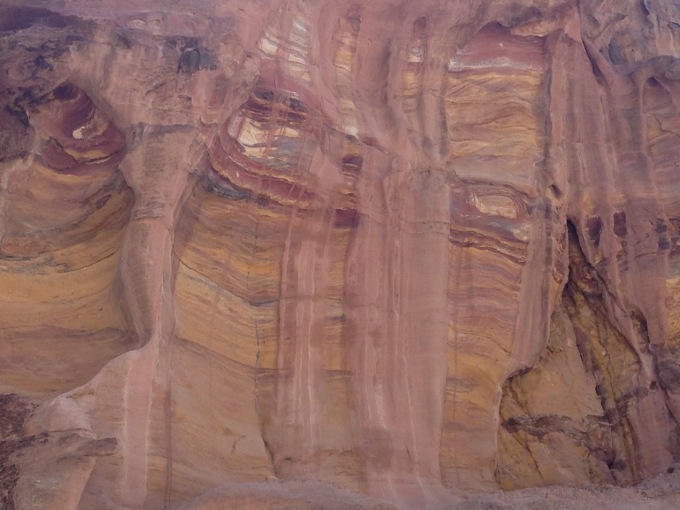
At the end, I could spy the Treasury through the rock walls.

Emerging out of the narrow corridor, the space widened to accommodate for a huge crowd of people riding donkeys and camels.
More than two thousand years old, Petra was built by the Nabataeans in the heart of the Shara Mountains. It was a vital part of a major trading route connecting ancient Mesopotamia and Egypt. Being such an economic hub, the city of Petra contained not only a treasury, but also tombs and houses.
Here is a big hive of houses.

An amphitheatre.

Some tombs.

While walking past one of the tombs, our guide introduced us to a Kiwi who was running one of the local stores. She had an incredible story to tell of how she came to Petra with a university friend in 1978. After meeting a Bedouin trinket salesman and “falling in love with his eyes”, she moved into his cave and married him two months later. I can’t imagine her parents’ reaction when they found out by post. She ended up raising a family in Petra and now has grandchildren there. She wrote a book about the her adventure (http://poppieshavelocknorth.circlesoft.net/p/994124?barcode=9781844082193).
After a brief stop for lunch, I split up from the main group and joined two Australians and two New Zealanders for a walk up Ad-Deir Mountain where the Monastery is located.
The walk itself wasn’t too steep, but its difficulty was compounded by the intense heat.
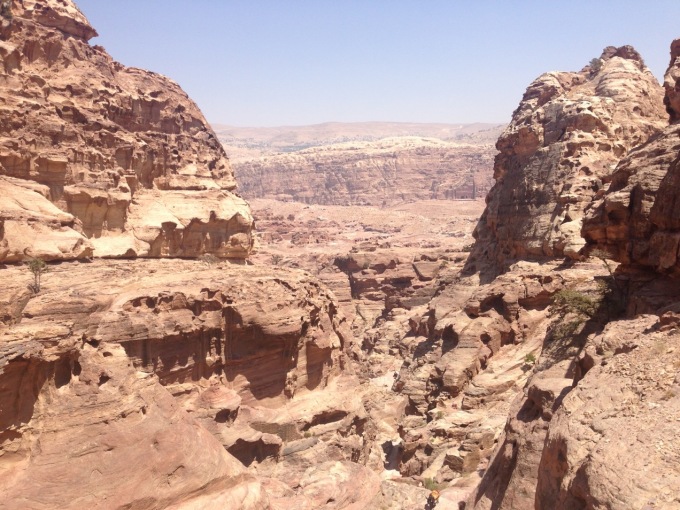
It was worth it to see the monastery though. While not as intricate as the Treasury, it had certainly been better preserved.
A few hundred metres beyond the monastery was a viewpoint over the mountains and valleys.
You were protected from the steep drop of the cliff by some makeshift barriers.

I was a bit of a trendsetter for this photo. Soon after, a line of people wanting to copy me formed.

On the way back to the entrance, we took many detours to pretend to be tomb raiders and explore the caverns Indiana Jones style.
The most rewarding part was seeing the different colour ceilings in each of the rooms.

How some of the structures survived the millennia since the earthquake was a struggle to comprehend.

Leaving the city, I enjoyed the Siq again in the golden afternoon glow.
A half an hour drive away was Little Petra. Little Petra was the stop for the trading caravans which sometimes reached a size of 2000 camels. The suburb was full of ancient ‘hotels’ such as this one:

You could spot hidden stairs in the cliffs like a game of Where’s Wally and trace them to yet more guest rooms.

This local let me take his photo in one of the BnBs.

Some local children even did a cultural performance for us before we left.

A couple of sandwiches for dinner went down well before a quick night swim and bed.
Day 153 (10th of August, 2016) – Wadi Rum, Jordan
In the morning we were awarded a well deserved sleep in before a mushroom soup lunch together in central Petra.
I spent the morning enquiring about cottages to rent over the new year in Finnish Lapland, and became quite worried at how quickly things were booking out. I found a few suitable places which are still available and I am in the process of negotiating prices and transport.
I also booked flights to and from Iceland in January, which is very exciting. I’ve always wanted to visit the land of Björk.
We all boarded the bus for the two hour drive to Wadi Rum. Wadi Rum is the famous desert area of Jordan. Tourists flock to their own isolated patch of the land to go camel riding and quad biking.
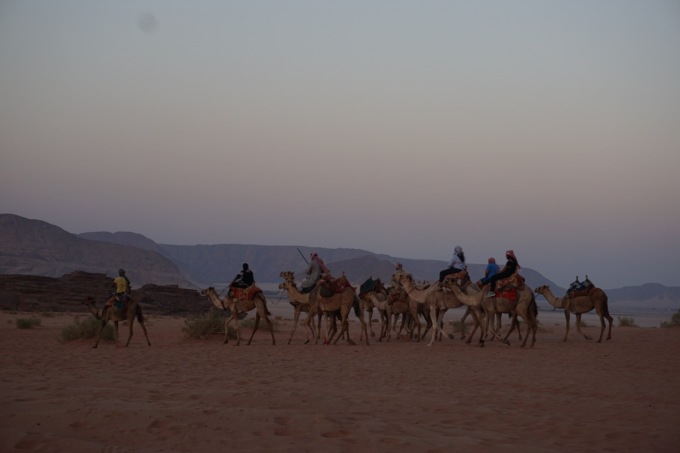
As we drove out, it became very evident why this landscape was used in the filming of movies such as Star Wars: Episode I and The Martian.
As our camp grew closer on the horizon, I knew that we were in for an exciting night.

The tents were like saunas on the inside, but the setup was good.
The communal areas were nice too.

After a brief stop at the camp, we all jumped on the back of some Toyotas to go joyriding in the desert.

These are the cars of choice in the Middle East including for groups such as ISIS. There’s been many reports on the unusual amount of these Toyotas in the hands of the terrorist group, and you can see why they use them. They were incredibly effective for the terrain.

The car moved incredibly fast and the driver would swing past low hanging rock or speed over hills to make it like a rollercoaster ride.
We made a few stops in the desert including at a huge sand dune. I spent half an hour desperately climbing up to the top of it. I was also able to climb a view dozen metres up the mountain on top before it became too steep and dangerous.

I sprinted down the huge hill, tempting my fate of stumbling and falling like a ragdoll.
The next stop was at this carving on a rock face. This was engraved in the 2nd millennium BC, predating the Nabataeans and the alphabet altogether.

It was the oldest thing I’ve seen on the trip so far. You could even go up and touch it.

You could make out figures such as men on camels holding spears.

We continued driving as the sun began to set and it made for some beautiful views.



Between the huge mounds of rock we stopped to observe the famous Lawrence Camp.

Our last stop was to soak up some of the incredible views created by the rock structures and the sunset.
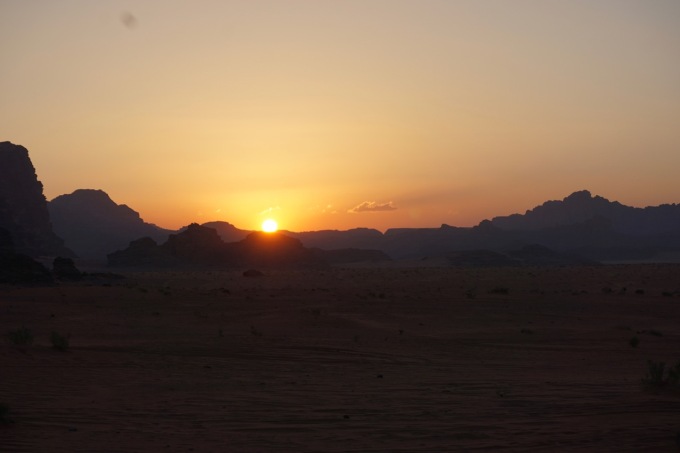
In the background of this photo you can see the edge of Saudi Arabia.

Back at the camp we settled in for a dinner of lamb and vegetables. It had been cooking throughout the afternoon in the traditional Bedouin way – buried under the sand.

We ate by the fire and ended the night staring into the sky and trying to spot the occasional shooting star.

I got into such an interesting conversation with one of my travel partners that I ended up staying out to watch the stars until the early hours of the morning. It didn’t make any sense to return to the tent, so I slept there for the evening.
Day 154 (11th of August, 2016) – Aqaba, Jordan
Sleeping outdoors made for a naturally early wakeup, but I wasn’t too fussed. I spent the morning drinking Jordanian sweet tea before having a breakfast (which, like almost every breakfast so far in the Middle East, has consisted of flat bread and yoghurt).
The drive to the next city of Aqaba was only two hours. Aqaba was founded around 4000 BC and there’s little wonder as to why. It’s Jordan’s only coastal city and sits smack bang in the middle of everything that is the Red Sea.
The group agreed without hesitation to all chip in for a boat ride to explore this marvel where we could also snorkel and scuba dive.
The first thing you notice about the Red Sea is the striking royal blue of the water.

The Red Sea also marks the meeting point of many countries. You can spot Saudi Arabia and even part of Egypt in the distance. Just a few hundred metres away from our boat was Israel.

We were having the time of our lives.

What’s occurring in this very photo ended up being our downfall. Without thinking, the whole boat cracked open some drinks to enjoy the ride, and we were told a bit too late that you couldn’t have had anything to drink if you wanted to scuba dive. It was a shame, but you can hardly blame them for doing their job. I just wish I was told earlier. We all resorted to snorkelling instead.
We pulled up close to a beach bordering Saudi Arabia and dived in.
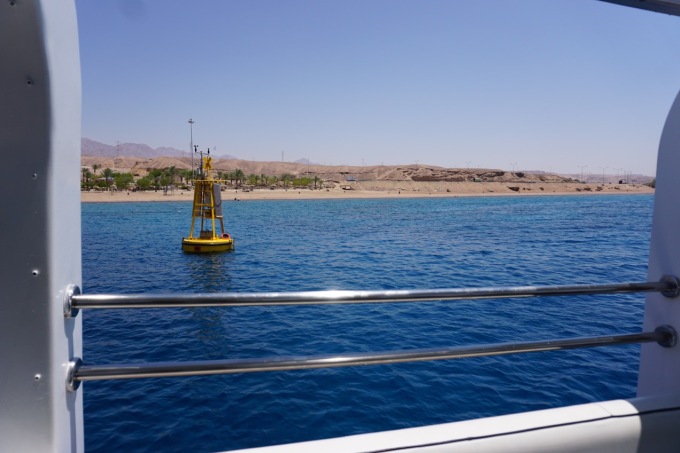
I spent most of my time jumping off the top of the boat.
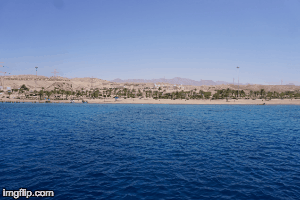
The snorkelling was unbelievable. The sheer quantity of fish and coral really made it clear as to why this place ranks in so many of the ‘World’s Best Places to Dive’ lists. The best thing which I saw was a shipwreck. The huge vessel had its control tower poking up to near the surface of the water, and so I was able to dive down and look at all the fish living within.
Stepping off the boat back in Aqaba and walking away from the water made me realise just how unbearably hot and humid the air was. We all rushed back to the hotel to relax for the night.
Unfortunately, a lot of the restaurants which the group is going to aren’t fitting in my budget. I escaped for a cheap soup before continuing the now arduous task of securing accommodation over the Christmas and New Year period.
Day 155 (12th of August, 2016) – Amman, Jordan
In the morning, the downfall of the tour group became painfully evident. A forty minute wait for someone who was taking their time at breakfast was made all the worse by the fact that they didn’t offer any sort of apology. Most people looked past it and we moved on.
It was a three hour drive from Aqaba to the Dead Sea, and most of the bus fell asleep for the trip. Stepping out of the bus at our destination, the forecast of “42℃, feels like 59℃” no longer seemed like hyperbole.
We entered the ‘Amman Beach’ complex, which also included a pool and restaurant.

Below the main area was the entrance to the Dead Sea.
The Dead Sea is Earth’s lowest elevation on land at 429m below sea level. It has 34.2% salinity, 9.6 times as salty as the ocean. As a result of the harsh ecosystem, the Dead Sea cannot house any flora or fauna (hence the name). The high salt content also means that the density of the water is substantially higher than the ocean at 1.24kg/litre. This gives swimming in the Dead Sea a very peculiar feeling – it’s hard to avoid floating straight to the top.

The water was 38℃, but the heat didn’t make the water any less refreshing. A group which was with our group earlier in the week had said that their Dead Sea visit was very underwhelming because of its saltiness and heat, and so my expectations were low. I’m thankful that they hated it so much, actually. Why? Because the Dead Sea absolutely shattered my expectations. I had the time of my life.
Just look at all the people staring at this ghost as it floated in the water.

Just a few steps into the water had your legs feeling unfamiliar. Once the water reached above waist height, you couldn’t help but be pulled up onto your back. It took me at least twenty minutes to have full confidence in my flotation. It’s genuinely a challenging mental game to have complete trust in resigning all energy to the water beneath you. Once I did it became a very, very relaxing experience.
Occasionally, a slight wave would splash onto my lips. The taste was the most abhorrent thing I have ever experienced. My face screwed up uncontrollably at each drop.
Worse, though, was any contact of your eyes with the water. You couldn’t help but have the occasional drop go under your sunglasses, and it was incredibly painful. Each time you would have to leave the water and wash out your eyes with freshwater – it was just too blinding.
People say that the high salt content of the Dead Sea and the minerals around it are very good for your skin. I paid some money to get completely mudded up so that I could take advantage of this.


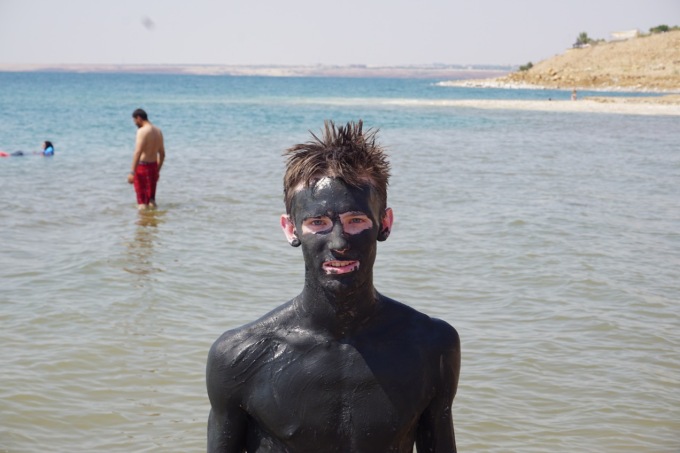
Eventually, the mud set like cake and I began the arduous task of getting rid of every spot. We’ll see if it paid off over the next few days.
Unfortunately, the rest of the afternoon was plagued by yet more waiting around for someone in the tour group. After a few hours of doing nothing, we moved on to a shop where people bought lots of skin products taken directly from the Sea. Then, we moved to our new hotel in Amman where I could finally wash off all of the salt.
Day 156 (13th of August, 2016) – Amman, Jordan
The morning began with an 8am breakfast where we all chatted as a group. I pulled my guide aside and reminded him, just like I had with my tour leader on the first day, that I would be needing 3-4 hours at the Israeli customs since I had an Iranian visa in my passport. I even offered that I take my own taxi to get to the border earlier than everyone else to play it safe.
My guide assured me that I only needed two hours.
“I’ve never seen anyone take longer than two,” he said, “just stay with the group and it will make things less complicated.”
I gave in and decided to trust his judgement. We planned to be at the border to go to Jerusalem by 4:30pm, since it closed at 6:30pm.
In the meantime, we firstly made our way to the Amman Citadel. Also known as ‘Jabal al-Qal’a’, this place was inhabited by different peoples and cultures until the time of the Umayyads in the 7th century from which point the site became ruins.
The site began with a breathtaking view over the surrounding districts of Amman (called Philadelphia in the time of the citadel’s operation).

I found it particularly fascinating how the most eye-catching structures were the towers of the mosques which stood well above the rest of the skyline. You could also spot the ancient city’s main amphitheatre from the hill.

The most dominating and well preserved structure in the citadel area is the Temple of Hercules built in 161 AD. The temple is named so due to the discovery of the arms of a huge marble statue beside the structure. Hercules, the supernaturally strong son of Zeus and Alcemene, was also minted on the Roman coins produced in Philadelphia.
Predating the temple and only a few metres from it is a cave used for burial during the Bronze Age in the 23rd century BC. The cave was later reused by the Umayyad stonecutters who constructed the citadel.

Contained in the citadel compound is a museum whose artefacts genuinely had me stunned. Rarely do you come across items from the Stone Ages, some 40000 – 60000 years ago.

Here is an infant’s burial from the Chalcolithic Period which lasted from 4300 to 3300 BC.

This is a skull bearing evidence of a Bronze Age surgery technique of drilling holes in the skull.

I’m surprised that glassware has still remained intact from so long ago.

You can see that the patient survived the first operation, and that the hole has started to heal.
Elsewhere in the compound is the Umayyad Palace. Built during the first half of the 8th century, this palace is now largely ruined. It has a restored domed entrance chamber known as the “kiosk” or “monumental gateway”.
Not far away from the Amman Citadel was Jerash. Jerash is the site of the ruins of the Greco-Roman city of Gerasa, and it is said to be the best preserved Roman ruins aside from Rome itself. It was founded by Alexander the Great or his general Perdiccas for the settlement of aged Macedonian soldiers. Gerasa was also part of the famous Decapolis – the group of major cities in the Roman Empire.
The grand entrance of the Arch of Hadrian seemed appropriate for the 20000-strong population of the city. This structure was originally built to honour the visit of emperor Hadrian to Jerash in 129/130 AD.
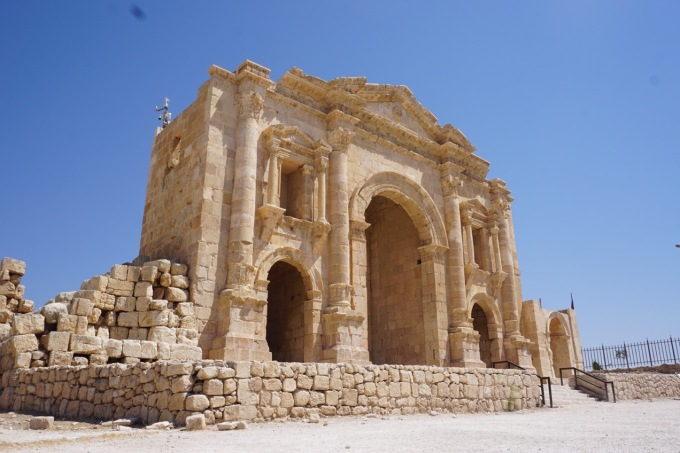
There was also a Hippodrome which could seat up to 50,000 to watch horse racing.
The city never seemed to end. There was always new districts and alleyways to explore. Many had survived the numerous earthquakes over past centuries remarkably well.
The Temple of Artemis atop the main hill was a struggle to reach in the heat, but well worth the effort.
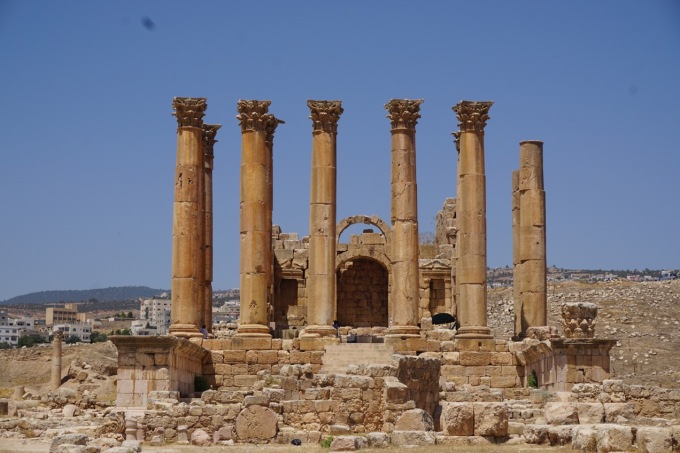
Just next to it was a theatre which was used by the ancient Romans for productions just like today.

Jordan was the last place I expected such rich Roman history, but it really puts into perspective just how influential and widespread the Roman Empire was.
To put it nicely, our guide makes sure that he’s always feeding his body plentifully. This has come to mean many food stops, including some very expensive restaurants (even by Australian standards) which we’re all roped into paying. This particular one was well worth the money, though.
The last stop of the day before the border was Ajloun Castle. This castle is in many respects the Islamic counterpart of Kerak Castle. It was built in 1183 on Salahuddin’s command as part of a military strategy to stop the expansion of the Crusaders. Its primary job was to protect the communication route between Damascus in Syria and the south of Jordan. It also protected the mining industry in the area which was central to the manufacturing of weapons.

The tunnels in its core were arguably more impressive and better preserved than those in Kerak.
Pictured here is some artillery for the catapults. I can’t imagine being hit by one of these.

From atop the castle you could spot the beginning of the mountains of Syria in the haze.

It’s incredible to think of the stark contrast in stability just a few kilometres in that direction. I don’t think I could empathise with the extent of the suffering of innocent families being slaughtered just over the border there – it’s just too foreign to me (despite its geographical proximity).
I made sure to get a photo in front of it. Smiling is probably not the right emotion, but oh well.

After stopping for our tour guide to get snacks (…), we were finally on our way to the border at the King Hussein Bridge. Despite the promise that we would arrive with two hours to spare before closing time, we arrived with just half an hour to go. Worse still, we didn’t actually get to the Israeli side until 6:25pm, just five minutes before they closed.
As soon as I stepped into the Israeli customs, the interrogation started.
“What’s your name? Your place of birth? Your father’s middle name?” the bombardment began.
“Why is your skin so white?” she asked me.
The sunscreen I’m using at the moment is more of a zinc, and it doesn’t rub in at all. I explained the situation.
“Show me the sunscreen” she demanded.
The customs officers around her began to empty my tube of sunscreen and examine the liquid by smelling it. Satisfied, they put my mostly empty bottle back.
After clearing the luggage section, I moved to passport control.
“What countries have you visited in the last three years?” they asked.
“Let’s see. Thailand, South Africa, China, Thailand, Iran, Jo—“
“Iran?”
I expected that. She motioned for me to go to another area where I was met by another officer.
“I’m sorry, sir, you’ll have to come back tomorrow. Applications like yours take three or four hours to get through, and we’re closing in five minutes.”
Briefly begging him for mercy did no good. Before I knew it, I was in a taxi back to Amman while the rest of the tour group continued into Israel. As the meter for the three hour journey ticked over, I began to realise the mounting cost that this incident would have. $100 for the taxi to Amman, $100 for a single room, $100 for a taxi back to the border the next day, $20 for another departure tax, $15 for the shuttle bus to Israel, $150 for the taxi from the border to Jerusalem. But, when you’re in trouble, you’ve got to spend whatever money you need to get out of it.
So, just like that, I had lost almost $500. But the part I was more devastated about was what I would be missing in Jerusalem while I jumped through all the hoops to clear customs the next day. The impact of the delay wasn’t known yet, so all I could do was focus on what I could control and get a good night’s sleep.
Before that could happen, I stated my case to the tour leader. I have never been treated worse by a company in my life. Despite the fact that I warned both her and the tour guide that this would happen, neither acknowledged that I had ever mentioned it. At one point, the tour guide even said that I never told her about having gone to Iran (despite every other person in the group testifying that I did in fact say it).
The tour leader hung up on me after I started getting agitated, so a call to Topdeck’s 24-hour emergency hotline was met with a computerised voice saying “this is the 24-hour emergency line, please leave a message”. So much for an emergency response.
After eventually getting in touch with the group in Israel, I organised to go back to the border as soon as it opened the next morning. In the meantime, I was in for a lonely night back in Amman.
There was one recommended Shawerma fast food place which I hadn’t had the opportunity to try out during my time in Jordan. I took the chance to go and find it. It was the sort of food you’d only enjoy after a few drinks, but I still devoured it.

The night finished with some more positive news. Aimee and I have secured a place to stay for New Years, and at a bargained down price too. We’re staying at the farmhouse of a family who live in rural Finnish Lapland. They will be cooking traditional meals for us for four days over the New Year, and we’ll get to do sledding, reindeer herding, snowshoeing and watching the Northern Lights with them (or on our own if we so desire). I can’t wait – it really will be a dream come true.
Day 157 (14th of August, 2016) – Jerusalem, Israel
It was Judgement Day. At 7am sharp, I caught a taxi to the King Hussein Bridge border crossing between Jordan and Israel. I slept for the two hour journey (it was shorter than last night because of no traffic), and upon arriving at the first checkpoint the taxi driver instructed me to get out of the car and go get my passport stamped.
“I will keep your luggage and meet you back here once you’re finished,” he said.
I started walking away, but came to an abrupt stop. I wasn’t comfortable that he had my luggage.
“Actually, would you mind if I took my bag? I can pay you now if you want.” I reasoned.
“No, no, you’re not allowed to take your bag into this checkpoint. You need me to drive you across the bridge. I’ll wait here.”
Hesitantly, I continued on my way. I turned around and snapped a quick picture of the taxi number plate just in case something went wrong.

Not long after, I found myself at the end of Jordanian passport control. I was directed to get on a shuttle bus to cross the bridge between the two countries.
“Where is your bag, sir?” I was asked by the driver who was packing the stowage.
“It’s in the taxi which is waiting for me outside, can I go out and get it?” I asked.
“What? No, you were supposed to bring everything with you. Taxis are’t allowed to do that.”
I began panicking. Eventually, after explaining my situation, I was allowed out of the gates while they held my passport to go and find the taxi. I suffered through the mental trauma of thoroughly scanning the 200m stretch of taxis and not finding my one. Reaching the end of the queue for a second time, I genuinely fell to my knees.
I had my passport, money and a brain with me. Everything else? Gone.
I yelled out of frustration, and a taxi driver came towards me asking what was wrong. I asked him to leave me be for a few minutes while I calmed down and considered my options. I figured there were a few ways this could work out:
- I continue to cross the border into Israel without my bag and cut my losses. A couple of grand later, I’d have a fresh wardrobe and nothing to worry about.
- I stay in Amman for as long as it takes to file a police report which would allow me to make an insurance claim on my losses. Then, I’d miss the rest of the tour and travel on my own for a few days.
I realised that regardless of which option I ended up taking, I had time to at least give tracking down my taxi a good attempt.
I approached the taxi driver who’d offered his help and asked if he could contact the taxi company to get onto the driver with this particular number plate. His attempt was unsuccessful, and so next we called the police. After much struggle translating the situation, I was told that a local team from the nearby office was coming to make a report. Twenty minutes later, I had resigned to the reality of what had just happened. There was nothing I could do – I consented to these sorts of accidents happening when I first decided to travel for a year. Something was always going to go wrong.
And then I spot it in the distance. My taxi driver was heading away from the border and coming towards me. It had to approach the bridge to make a u-turn since there was a concrete barrier separating the two lanes. I ran out into the road in front of the car, half-ready to jump out of the way if he didn’t slow down.
The taxi came to a halt. The driver jumped out and quickly started explaining himself.
“Where were you? You took so long, I thought you had already crossed the border so I was leaving.”
A few taxi drivers who’d joined in on the debacle had followed me and were yelling at my driver in Arabic. I asked one of the drivers with better English if he thought that the driver had tried to steal my bag or whether it was a big misunderstanding. He indicated that the driver had tried to steal it. I took out the money for the fare, threw it in the window of the taxi, unlocked the back door from the inside and took my bag to leave.
With my heart still racing, I reached the shuttle bus to cross the bridge. I was the last to board, and there was only one small space available to store a bag under the cabin. A French man in front of me was attempting to fit his large suitcase there, but it wasn’t working out. Misinterpreting his body language, I advanced to try put my own bag in the same spot after he had given up. It turns out that this was considered pushing in. He turned around and started abusing me in French. I understood it all, but was too flabbergasted to respond.
Before I knew what was happening, he had pushed me and kicked my backpack out of my hand. I retreated and the guards came over and tried to sort out what was going on.
I don’t really know how it ended other than that I got on the bus and nothing else was said of the incident.
Crossing the short bridge took half an hour, and eventually everyone rushed into the baggage check area. We checked in our baggage just like at an airport so that it could be collected after all the due processes. I then began my journey through the first of three passport stations. The first one, despite the long wait, had no issues.
At the second window, I was being interrogated like the previous night. Most of the questions revolved around my financial situation and how I could afford to travel for a year on my own. They also wanted to know why a traveller who’s fascinated by religion would spend nine days in Iran but only three in Israel.
I was also asked whether I knew anyone in Iran. After telling the authorities that I didn’t, they asked me again, adding: “We’re going to check your Facebook friends. So, do you know anyone in Iran?”
Before I had a chance to answer, I was jolted by the fright of someone yelling behind me. Turning around, I was swept up in the swarm of people all rushing to the side of the room. Some people were confused and I was worried because my passport was still at the second gate, but I thought that it was safer to just follow the crowd. Suddenly, an armed customs officer ran into the room and shouted “BOMB, BOMB!”
I have never seen a bigger rush of fear in my life. People were hysterical. We were told not to move and to remain patient by some officers. I noticed some Americans chatting calmly behind me and I asked them if they’d been in a situation like this before.
“This has happened before to me when crossing the border. If they see something suspicious in someone’s luggage, they’ll push everyone to the side of the room just in case it’s an explosive,” one said.
The other American added, “bomb’s just an effective word to get people to move”.
I found it a struggle to believe that this was legally OK, but I realised that Israeli customs did what they want, and that normal rules didn’t apply here.
I was eventually guided back to the second passport checkpoint. I confirmed that I knew no one in Iran and following that, I was told to sit in the waiting area until I was called. That was at 10:20am.
Fast forward to 2pm. I am still in the waiting area. Thank God they had free WIFI, otherwise I think that I would have died from boredom. I had already constructed a plan B of what to do if I was rejected from Israel, since the long processing time had me concerned that I wouldn’t be allowed in.
Eventually after almost four hours I was alleviated of that fear. I received my passport and a separate card with my entry stamp (used so that Middle Eastern countries like Lebanon, Saudi Arabia and Iran don’t know that I’ve been to what they call ‘occupied Palestine’, which would bar me from entry into their countries).
The third checkpoint was quick and easy, and before I knew it I was on my way to link up with my tour group. The taxi cost a fortune (Israel is much more expensive than Jordan), but I didn’t have any other choice. I was dropped off at Master’s Gate where, after they spotted me looking confused, some shopkeepers helped me to track down my guide. While we were trying to find him, I made quite good friends with the shopkeeper’s son, a twelve year old boy. He taught me my first few words in Hebrew.
The first glimpse I got of the city of Jerusalem was from the top of the Mount of Olives.

I find it interesting how the icon of Jerusalem is a mosque (the Dome of the Rock) and not a church or synagogue.

In the valley between this mountain and the Old City of Jerusalem lies the Mount of Olives Jewish Cemetery. This site was first built some 3,000 years ago in the First Temple Period, and it retains its original function today. These days, 70000 people are buried at the site and it costs US$1000000 to get your grave added to the list. People are buried with their feet towards Jerusalem. This is because in the Old Testament, it states that the Messiah will appear on the Mount of Olives and walk towards the golden gates of Jerusalem. The Resurrection of the Dead will occur at this time, and by being buried with their feet towards the gate, the people whose remains are in this area will be able to rise and walk directly to the holy city of Jerusalem with the Messiah.
Connected to the cemetery were dozens of ancient relics and burials. Here is a cave full of tombs from 100 BC to 100 AD, and you can even spot Christian symbols engraved on the walls from people who visited the site later in history.

There is also the row of trees where it is said that Jesus’ crown of thorns was collected.

Looking over Jerusalem and being guided through the sites of all these monumental historical events was an incredibly spiritual experience. It was made all the more significant because I was being told stories which I grew up with both in my family and school, and I was finally seeing their setting in real life.
Partway down the Mount of Olives was the Dominus Flevit Church. Dominus Flevit can be translated to ‘The Lord Wept’. It is named so because of the 19th chapter of the Gospel of Luke where Jesus, while riding toward the city of Jerusalem, becomes overwhelmed by the beauty of the Second Temple and predicts its future destruction, thus weeping openly.
The altar on the inside breaks tradition by not facing East.

This is for very good reason, though. If you stand in the middle of the church and look out at the city of Jerusalem, the church’s cross actually lines up perfectly with Golgotha, the location of Jesus’ crucifixion.

Just outside, you can spot the location of Mary’s assumption, Jesus’ ascension and Jesus’ tomb. In this picture, the church in the distance marks the location of the Last Supper.

I found one of the most visually spectacular churches on the Mount of Olives to be the Church of Mary Magdalene, a Russian Orthodox church built in 1888 by Tsar Alexander III.

We continued to walk down the mountain, winding our way through narrow alleyways. This is said to be the path that Jesus took to enter Jerusalem on Palm Sunday.

At the base of the path was the Garden of Gethsemane. According to the New Testament, Jesus and his disciples frequently visited this place. It is also where Judas found Jesus on the night of his arrest. Some of the olive trees are so old here that they are said witnessed to agony of Jesus as he prayed before his imminent death (carbon dating has contradicted this, though).

Adjacent to the Garden of Gethsemane is the Church of All Nations, also known as the Basilica of the Agony. It enshrines a section of bedrock where Jesus is said to have prayed before his arrest.
Our driver picked us up from the bottom of the mountain where we were transferred back to the hotel. I was able to be dropped off at Damascus Gate where I could catch up on the missed sightseeing.

As soon as I got out of the car, I stopped for a well deserved lunch.

Afterwards, I entered the Damascus gate and began making my way through the Souk within.
You can see in many of these pictures the widespread usage of traditional Jewish attire. With 62% of the city’s population being Jewish, this makes a lot of sense.
The first Holy site was the Church of the Holy Sepulchre.
This church contains the two holiest sites in Christendom: the site where Jesus was crucified as well as his empty tomb (the location of his burial and resurrection). Dozens of pilgrims around me were becoming emotional as they entered the site and reflected on the suffering and miracles that occurred there.

Nearby the Church of the Holy Sepulchre is arguably Jerusalem’s most well known site – the Western (or Wailing) Wall. Today is a particularly important day for Jews to visit the site since it is ‘Tisha B’Av’ – a day to commemorate the anniversary of a number of disasters in Jewish history, primarily the destruction of both the First Temple by the Babylonians and the Second Temple by the Romans in Jerusalem.
Jews were gathering at the wall, which is the last remnant of the Western Temple Mount retaining walls, to pray for the Temple’s rebuilding.

Within the original Temple is said to be the focal point of creation – where Adam came into being and Abraham, Isaac and Jacob served God.
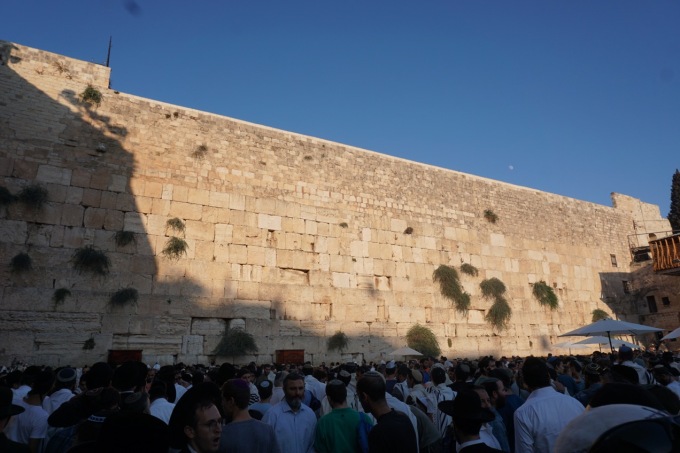
The clothing of many of the people at the site was particularly interesting.
In the second picture, a man wears part of the Torah strapped to his head to put the Holy Book “between the eyes and before God”.
Being such an important day in the Jewish calendar, the police presence was very noticeable.

It was also not uncommon to see regular people with handguns allowed under ‘concealed carry’ laws due to the high rate of Palestinian lone wolf attacks.
Following my adventure in Jerusalem’s Old Town, I caught the tram back to my hotel near central station.

I’m glad that I ended up seeing many of the most important Christian sights of this historical city. It’s an incredible place – a Rome with better history but worse food. I’m looking forward to seeing more of this fascinating country tomorrow.
Until next time,
Xavier.




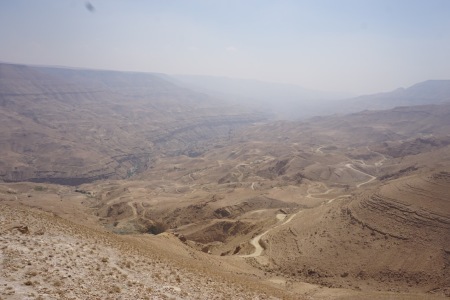
















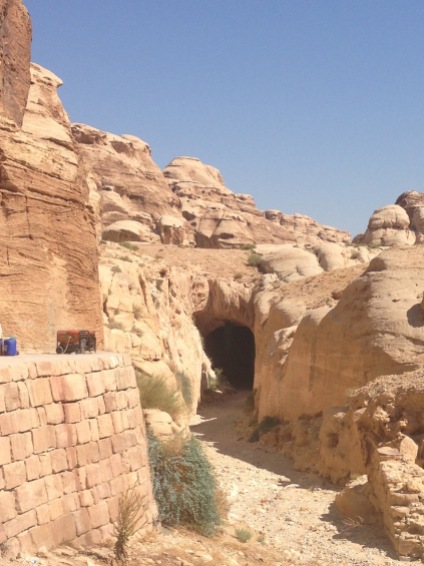






























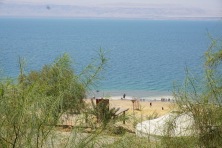







































Fabulous read, darling. Love you x
>
LikeLike
Glad you enjoyed it mum!!
>
LikeLike
Firstly Congratulations on the scholarship Xavier !
Secondly my blood pressure went to about 220 just reading that.
Thirdly Stay safe and fourthly if at any stage Dan says “let me handle this” DONT LET HIM.
Best wishes
Uncle Tone
LikeLike
Thanks Tone, means a lot. It was a pretty intense week that’s for sure. China surely won’t present the same complications when Dan comes over! Hope you’re well.
>
LikeLike